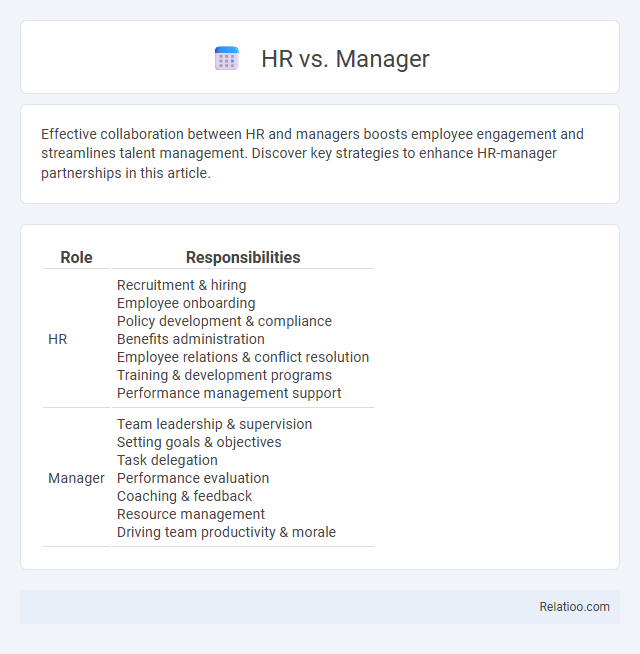Effective collaboration between HR and managers boosts employee engagement and streamlines talent management. Discover key strategies to enhance HR-manager partnerships in this article.
Table of Comparison
| Role | Responsibilities |
|---|---|
| HR |
Recruitment & hiring Employee onboarding Policy development & compliance Benefits administration Employee relations & conflict resolution Training & development programs Performance management support |
| Manager |
Team leadership & supervision Setting goals & objectives Task delegation Performance evaluation Coaching & feedback Resource management Driving team productivity & morale |
Understanding the Roles: HR vs Manager
Understanding the distinct roles of HR and managers is crucial for addressing workplace issues such as harassment effectively. HR is responsible for creating and enforcing company policies, ensuring legal compliance, and providing support during investigations, while managers handle daily team dynamics, communicate expectations, and report any concerns to HR. Your proactive collaboration with both HR and managers strengthens the organization's ability to maintain a safe and respectful work environment.
Key Responsibilities of HR Professionals
HR professionals play a crucial role in preventing and addressing harassment within the workplace by enforcing company policies and conducting thorough investigations. Your HR team is responsible for training managers on legal compliance, promoting a safe work environment, and ensuring employee concerns are handled confidentially and promptly. They act as intermediaries between employees and management to resolve conflicts and maintain a respectful organizational culture.
Core Duties of Managers
Managers play a crucial role in preventing workplace harassment by fostering a culture of respect and promptly addressing any complaints. Their core duties include identifying potential harassment issues, enforcing company policies, and ensuring a safe work environment. Collaboration with HR is essential for training, investigation, and implementing corrective actions to maintain compliance with legal standards.
Strategic Focus: HR vs Managerial Objectives
HR departments prioritize strategic alignment of workforce planning, talent development, and organizational culture to drive long-term business success. Managers focus on achieving specific team goals, operational efficiency, and performance metrics within their units. Your role in addressing harassment involves collaboration between HR's policy enforcement and managers' immediate action to ensure a safe, compliant workplace.
Recruitment and Talent Acquisition: Who Leads?
In recruitment and talent acquisition, the manager typically leads by defining role requirements and evaluating candidates' fit within the team, while HR supports with sourcing, screening, and ensuring compliance with policies. Your organization's approach to preventing harassment starts with HR establishing clear guidelines and training programs, complemented by managers enforcing respectful workplace behavior during the hiring process. Effective collaboration between HR and managers ensures a fair, compliant recruitment cycle that attracts top talent while safeguarding against harassment risks.
Performance Management: Shared or Separate Tasks?
Performance management responsibilities often require clear delineation between HR and managers to enhance effectiveness and reduce conflicts. Managers directly oversee employee performance, setting goals, providing feedback, and coaching, while HR develops policies, monitors compliance, and supports legal frameworks around performance issues and harassment concerns. Collaboration ensures that harassment incidents linked to performance are addressed promptly, with HR managing investigations and managers maintaining ongoing performance dialogues.
Employee Relations: HR’s Domain or Manager’s Duty?
Employee relations primarily fall under HR's domain, as HR professionals develop policies, conduct training, and ensure compliance with labor laws to prevent harassment. However, your direct manager plays a critical role in implementing these policies, addressing concerns promptly, and fostering a respectful workplace culture. Effective collaboration between HR and management is essential to protect employees and maintain a harassment-free environment.
Training and Development: HR Support or Manager Initiative?
HR plays a crucial role in designing and delivering comprehensive training programs to equip managers with the skills to identify, prevent, and address workplace harassment effectively. Managers, supported by HR initiatives, must take the initiative to implement these training sessions and foster a safe, respectful work environment. Your organization's success in harassment prevention depends on the collaboration between HR's structured support and managers' proactive leadership.
Conflict Resolution: HR vs Line Manager Approaches
HR departments implement structured conflict resolution policies emphasizing neutrality, documentation, and adherence to legal frameworks, ensuring unbiased investigations into harassment claims. Line managers often address conflicts through direct communication and mediation within their teams, leveraging personal relationships and immediate context to resolve issues quickly. Combining HR's formal procedures with managers' on-the-ground insights creates a comprehensive approach to resolving workplace harassment effectively.
Collaboration for Organizational Success
Effective collaboration between HR and managers is essential in preventing workplace harassment and ensuring organizational success. HR provides expertise in policy development and training, while managers enforce standards and foster a respectful team environment. Your proactive engagement in this partnership helps create a safe, inclusive culture that drives productivity and employee satisfaction.

Infographic: HR vs Manager
 relatioo.com
relatioo.com